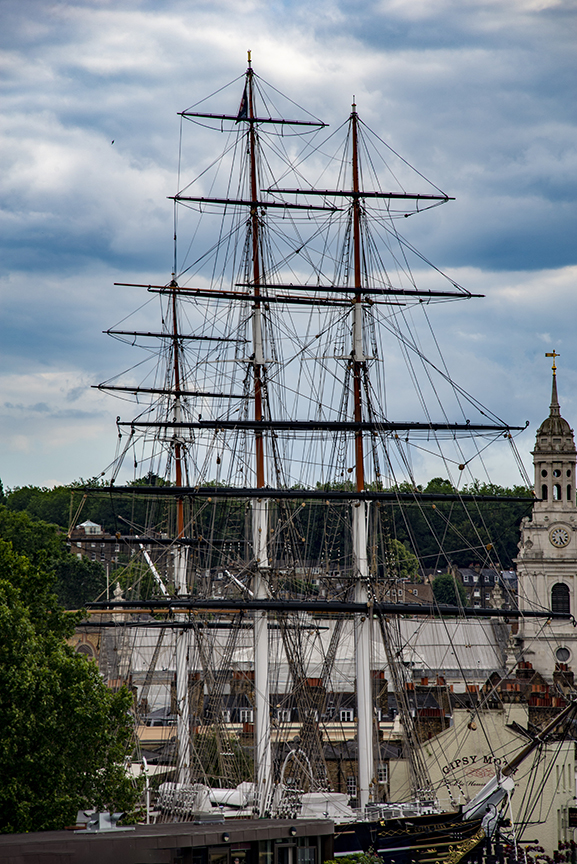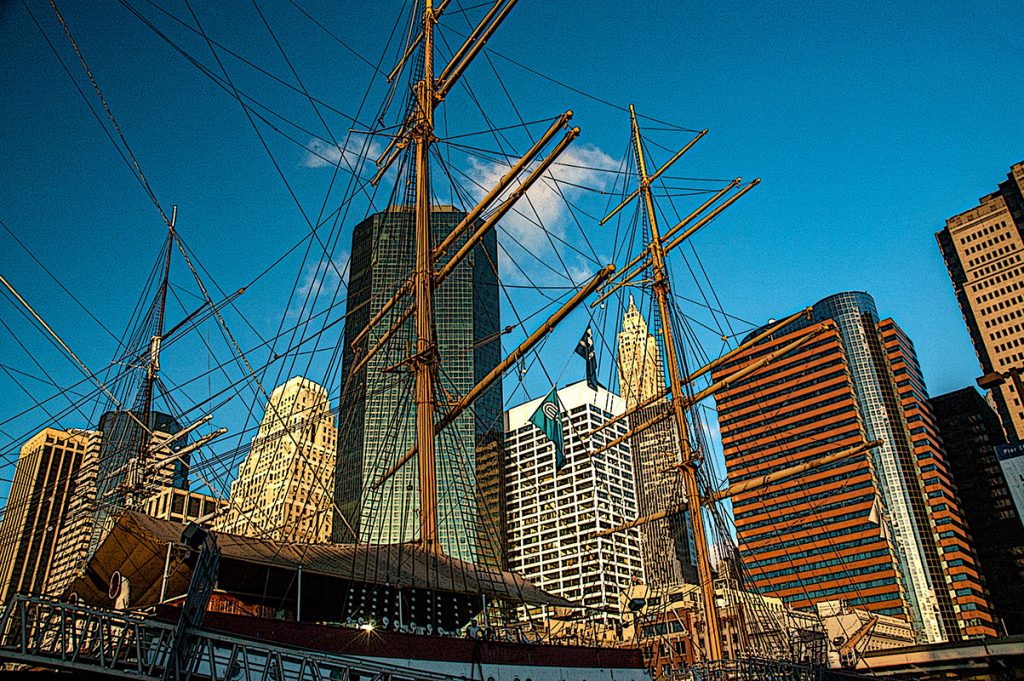By Corey Sandler
In September I wrote about the view of Boston’s historic harbor from my office window and specifically about three interlinked tall ships: USS Constitution (“Old Ironsides” in informal, boastful references), USCGC Eagle, and the sailing ship Sea Cloud.
As is the case with most of the lectures I give around the world, pulling on a single thread of information almost always leads deeper and deeper into a story. And so I spent some time examining images from my trove of many thousands of photos from my travels.
Herewith, some true tales of tall ships.
Cutty Sark: Last of the Tea Clippers

The Cutty Sark was one of the last tea clippers to be built, and one of the fastest, although the timing of her launch was not great. Steam-powered vessels were beginning to take over, and in 1869 the Suez Canal was opened; the age of sail-powered cargo ships waned rapidly.
Cutty Sark was built in Dumbarton, Scotland in 1869 and intended to carry tea from China, which she did for a few years before switching routes to the trade in wool from Australia. After then she moved to other routes including carrying minerals in South America.
How fast was she? Her maximum recorded speed was 17.5 knots (about 20.1 miles per hour). That is about equal or greater than ordinary operating speeds for modern cruise ships.
Since 1954 she has served as a museum ship, perched on dry land atop a bluff in Greenwich, England, just short of London on the River Thames.
Vasa: Beauty Over Engineering

Vasa sank on her maiden voyage on August 10, 1628 in Stockholm harbor. Built on orders of King Gustavus Adolphus, she was at that time one of the most powerfully armed warships in the world and also one of the most lavishly decorated.
Oh, and also spectacularly top-heavy.
When she was launched, she sailed less than a mile before a puff of wind rolled her over.
The Swedes salvaged some of her heavy bronze cannons and then all but forgot about the vessel for three centuries. A Swedish amateur archeologist found her in a shipping lane in 1956.
The almost-intact ship was conserved and restored, a process than took nearly three decades, and now lives on in a museum in Stockholm. There are few places that can match the Vasa Museum as a place for instant time travel.
The Flying P-Line Peking

Peking was a Flying P-Liner of the German company F. Laeisz, which named nearly all of its vessels after places beginning with the 16th letter of the modern English alphabet.
She was built in Hamburg, Germany and made her maiden voyage to Valparaiso, Chile in 1911 carrying nitrate and wheat around Cape Horn.
The huge ship was a bit more than 377 feet from spar to stern and could hoist 44,132 square feet of sail, which is a bit more than an acre in total
With the outbreak of the first World War in 1914 she was interned there and was later given to Italy as war reparations, going on to owners in the Weimar Republic and then the United Kingdom. She was acquired by the South Street Seaport Museum in New York City in 1975, and in 2017 was transferred to the German Port Museum of Hamburg where she is on display now.
Statsraad Lehmkuhl in Bergen

Statsraad Lehmkuhl is a three-masted barque built for the German merchant marine in 1914 as a sailing training ship. After the first World War it was taken as war reparations by the United Kingdom, and then in 1921 purchased by a former Norwegian cabinet minister.
At the outbreak of World War 2, she was seized by the Germans, but repatriated after the war.
She is now operated by a foundation as a training ship, under a Norwegian name which translates as “Cabinet Minister Lehmkuhl”.
Statsraad Lehmkuhl is a sister ship to Dar Pomorza, which today is a museum ship in Gdynia, Poland.
The vessel is about 311 feet in length from spar to stern, and is little changed from when she was built, with one exception: in 2019 her diesel auxiliary engine was modified to work with battery power that can be recharged by the wind or the engine.
Roseway Near the Greenway

I once owned a handsome sports car with an ambitious engine; it looked like it was breaking the speed limit even when parked at the curb.
That’s the feeling I get when I see the Roseway, a wooden gaff-rigged schooner at her slip on the south side of Boston harbor.
She was built in 1925 in Essex, Massachusetts as a fishing schooner, but also with an eye on competing in the offshore fishing boat races held in Atlantic Canada at the time. (The most celebrated fishing/racing vessel of the time was the Canadian schooner Bluenose, the “Queen of the North Atlantic.” That ship, which wrecked in 1946, is remembered on the reverse side of the Canadian ten-cent coin.)
Roseway never won the big race, but was much beloved in American waters and in 1941 retired from fishing/racing to become a pilot boat in Boston Harbor during World War II and also served as a special-purpose U.S. Naval vessel with a .50 caliber machine gun aboard.
After the war, Roseway resumed its role ferrying harbor pilots in Boston, the last such sailing vessel in the United States when she was retired in 1973.
Today Roseway is operated by World Ocean School, a non-profit educational organization based in Boston, sailing in the summer up north and in winter from Saint Croix in the U.S. Virgin Islands.
By coincidence (and for confusion’s sake) her dock is very near the Rose Kennedy Greenway, a park installed atop the Big Dig roadway along Boston’s waterfront which replaced the urban blight of the I-93 elevated roadway which cut off the city from its historic and handsome harbor for two decades between 1991 and 2006.
I hope you’ll join me in these pages in November for more maritime musings.
Photos and text copyright Corey Sandler. To obtain copies or otherwise use images, please contact me through my website at www.coreysandler.com
To see portfolios of some of my travel photos visit www.coreysandler.myportfolio.com or www.coreysandler2.myportfolio.com
